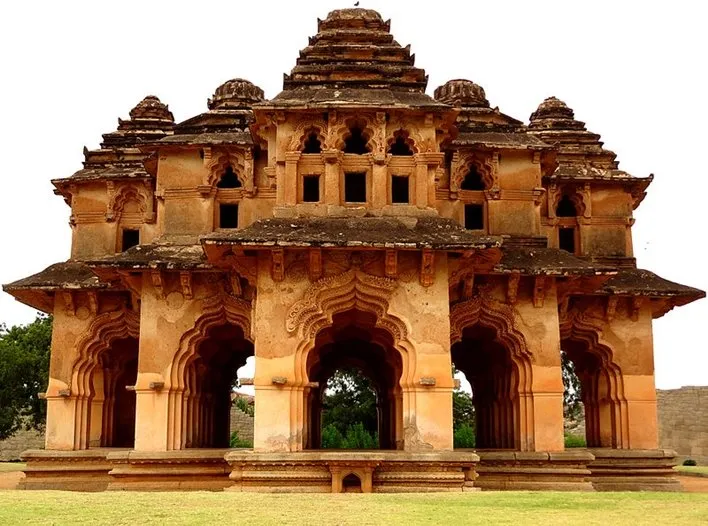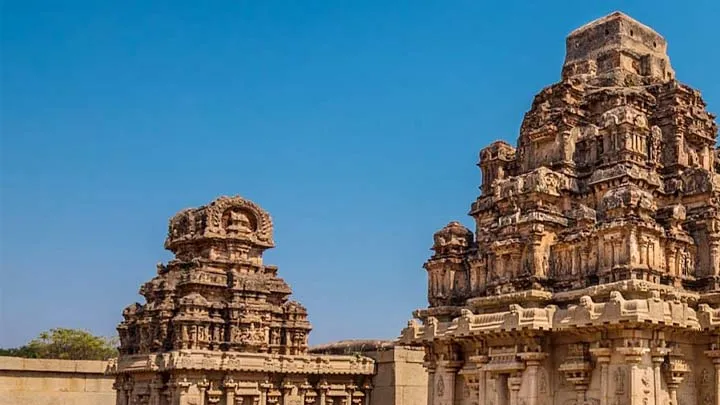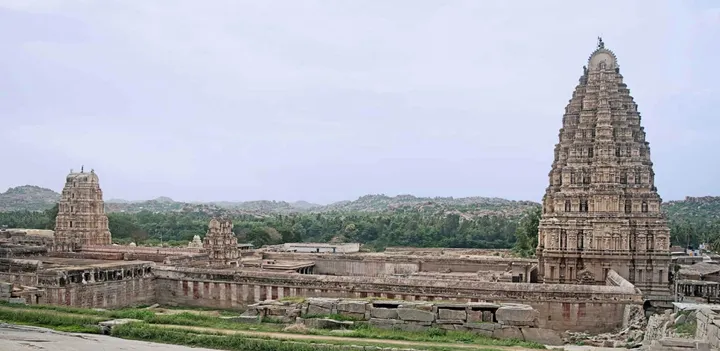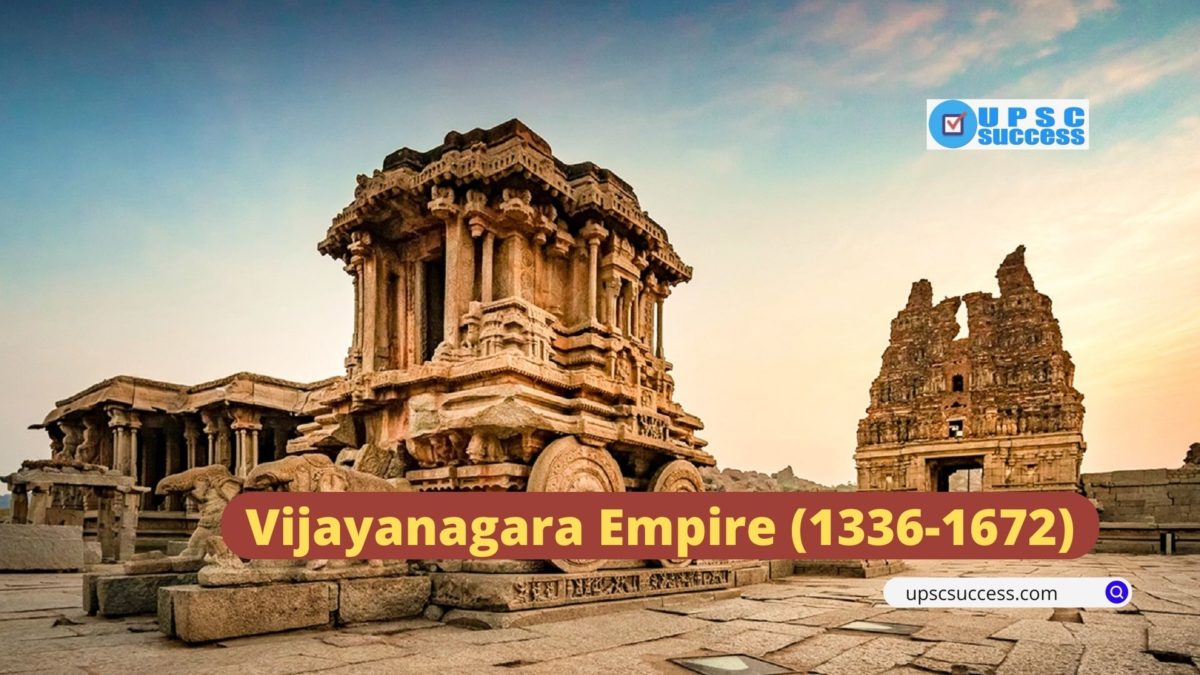Contents
By the end of the Sultanate Period, Multan and Bengal were the first territories to break away from Delhi and declared independence. Many other territories in the Deccan region also rose to power.
The ‘Vijayanagara’ or ‘City of Victory’ was the name of the city as well as an empire that was founded by two brothers, Harihara and Bukka in 1336 AD.
It was on the southern banks of the Tungabhadra river. They made Hampi the capital city. Before they served under Kakatiya ruler of Warangal.
The sources of Vijayanagar empire history include accounts of foreign travellers, Indigenous Works (local vernacular literature), and archaeological excavations.

Vijayanagar Empire was Ruled by
- Sangama dynasty (1336-1486)
- Saluva dynasty (1486-1506)
- Tuluva dynasty (1506-1565)
- Aravidu dynasty (1570-1647)
Sangam Dynasty
Harihara (1336–56)
- In 1336 Harihara became the ruler of Sangama Dynasty.
- By 1346, the whole of the Hoyasala kingdom had passed into the hands of the Vijayanagar rulers.
- By 1377, the sultanate of Madurai was completely wiped out.
- Vijayanagar empire then comprised the whole of south India upto Rameswaram.
- Bagepalli Copper Plate Inscription of Harihara I tells us about his achievements.
- In 1356 Bukka succeeded Harihara.
Deva Raya II (1424–46)
- Deva Raya II was the greatest ruler of the Sangama dynasty.
- He acquired the title of Gajabetegara.
- In order to strengthen his army, he inducted more Muslims in his army.
- He asked all his Hindu soldiers and officers to learn the art of archery from the Muslim army.
- Srirangam copper plates of Deva Raya Il list the various achievements of the ruler.
- Sanskrit poet Gunda Dimdima and Telugu poet Kavisarvabhauma Srinatha, author of Haravilasam, were in his court.
- Persian traveller Abdur Razzak visited his court.
Saluva and Tuluva Dynasty
- After some time of the death of Dev Raya II the throne was usurped by the king’s minister, Saluva Narasimha.
- Thus the Sangama dynasty came to an end and the Saluva dynasty was established.
- The Saluva dynasty also soon came to an end, and a new dynasty called the Tuluva dynasty was founded by Vira Narasimha.
Krishna deva Raya (1509-29)
Krishnadevaraya was the king of Vijayanagara Empire who reigned in the 16th century over most of South India.
Achyuta Deva Raya (1529 – 42)
- Achyuta Deva Raya was the younger brother of Krishna Deva Raya.
- Portuguese traveller, Fernoa Nuniz, came to India during his reign.
- He patronised the Kannada poet Chatu Vittalanatha, the great singer and composer Purandaradasa (father of Carnatic music), and the Sanskrit scholar Rajanatha Dindima II.
- The Tiruvengalanatha temple is now popularly known as the Achyutaraya temple.
- Tenali Rama, the author of Panduranga Mahatyam also was a famous poet in this region.
Rama Raja
- Ram raja was a son-in-law of Krishna Deva Raya.
- He was able to playoff various Muslim power against one another.
- He entered into a commercial treaty with the Portuguese.
- Ram Raja completely defeated the Bijapur ruler.
- Then he allied himself with the Bijapur ruler to inflict humiliating defeats on Golconda and Ahmednagar.
- However, his enemies (except Berar) ultimately combined to inflict a crushing defeat on Vijayanagar at Bannihatti, in the Battle of Talikota, in 1565.
- This battle is also known as the Battle of Raksasa Tangadi.
- Rama Raja was imprisoned and immediately executed.
- The city of Vijayanagar was destroyed. This battle was generally considered to mark the end of the Vijayanagar Empire. However, the Vijayanagar kingdom existed under the Aravidu dynasty for about another century.
Aravidu Dynasty:
- Thirumala, Sri Ranga and Venkata II were the important rulers of this dynasty.
- Venkata II was contemporary to Akbar. He shifted capital city to
- The last ruler of the Vijayanagar kingdom was Sri Ranga III.
- Sri Ranga was defeated by Mir Jumla of Golconda in the battle of Vandavasi in 1647.
- Vijayanagar empire came to an end with this.
Revenue:
- Land revenue was the major source of income for the state.
- Generally, it was at the rate of one-sixth of the total produce.
Religion:
- The Sangama rulers were chiefly Saivaites and Virupaksha was their family deity. But other dynasties were Vaishnavites.
- But all kings were tolerant towards other religions. Borbosa referred to the religious
freedom enjoyed by everyone. - Muslims were employed in the administration and they were freely allowed to build mosques and worship.
- Shunya sampadane– a collection of vachanas produced in this age.(vachanas literally meaning sayings in kannada, these are poetic verses composed in kannada language, popularized by veershaiva movement led by Basavanna).
Literature:
- Sanskrit, Kannada, Telugu language witnessed voluminous literature in Vijayanagar period.
- Few Sanskrit works are.
- Gangadevi wrote- Madhuravijayam
- Krishnadevarya wrote – usha parinayan, jambavanti kalyanam, madalasa charita.
- Guru vidyaranya wrote—Raja kalanirnaya
- Literary works in Kannada.
- Chamarasa wrote – prabhulingaleele
- Kanakadas wrote- Ramadhanacharite, nala charite, mohantarangini
- Kumaravyasa wrote – Karnataka katha manjari
- Purandardas — keertanas
- Literary works in Telugu
- Krishnadevaraya wrote – Amuktamalyada
- Allasani pedanna wrote – Manucharita
- Nandi timanna wrote – Parijathaparahana etc
- Ashtadiggajas– eight great poets of Telugu literature flourished in the court of Krishnadevaraya.
Trade and Commerce
- According to Abdur Razzak, the state had 300 seaports.
- The most important commercial area on the west coast was Malabar, with its important port Cannanore.
- Among the exports, the main items were cloth, spices, rice, iron, salt petre, sugar, etc.
- They issued Gold Pagoda or Varaha Coin.
Position of Women
- Women occupied a high position and took an active part in the political, social and literary life of the empire.
- They were educated and trained in wrestling, in the use of various weapons of offence and defence, and in music and fine arts.
- Nuniz writes that the kings had women astrologers, clerks, accountants, guards and wrestlers.
Architecture
They used the Dravidian style of architecture later added some unique features to it and it came to be called as Vijayanagara style.
The courtly architecture of Vijayanagar is generally made of mortar mixed with stone rubble and often shows secular styles with Islamic-influenced arches, domes, and vaults.
Some famous temples exemplifying the Vijayanagar style include the Virupaksha Temple at Hampi and the Hazara Rama temple of Deva Raya I etc.



Sources of Vijayanagar Empire
| Sources | Literary Works | Information |
| Foreign Traveller Accounts | Rehlatar Tuhfat-un-Nuzzat by Ibn Batuta | Account of the empire under Harihara I |
| Matla as Sadain Wa Majma ul Bahrain by Abdur Razzaq | An account of the reign of Devaraya II | |
| An Account of Countries Bordering the Indian Ocean and their Inhabitants by Duarte Barbosa | A vivid account of Vijaynagara governance under Krishna Deva Raya | |
| Domingo Paes gave the most detailed accounts of all historic descriptions of ancient city Hampi | Governance under Krishna Deva Raya of Vijayanagara Empire | |
| Fernao Nuniz gave a detailed account of the history of Vijaynagar. | Mentioned the cultural aspects of the empire and admire the jewels worn of women as well as how women were appointed in the King’s service and also detailed account on the foundation of the city | |
| Indigenous Works | 1. Manucharitam by Allasani Peddan 2. Gangdas Pratapa Vilasam by Gangadhara 3. Amuktarmalyada by Krishnadeva Raya | Polity and political ideas of the ruler’s society and the caste system |
| Archaeological Sources | Salu Vabhyudyam by Rajanatha Dindima | 1. A contemporary drama, deals with the siege of Vijayanagara city by the Brahmins and the Gajapatis of Odisha after the death of Deva Raya II 2. Historical eulogy of Saluva Dynasty |
| Inscriptions | Bagapellisi Copper Plate Inscription | Achievement of Harihara I |
| Bitragunta grant of Sangama II | Genealogy of 5 Sangama Brothers | |
| Channa Raya Pateeka Inscription of Harihara II | Successful invasions of Bukka I | |
| Srirangam Copper Plates of Deva Raya II | Achievements of Bukka I | |
| Devulapalli Copper Plates of Immadi Narasimha | Genealogy of Saluva Dynasty |
The history of the Vijayanagara Empire was recovered through the efforts of Mr. R Sewell, who was the Keeper of the Madras Record Office and was tasked with the responsibility for documenting ancient inscriptions and remains in the region.

